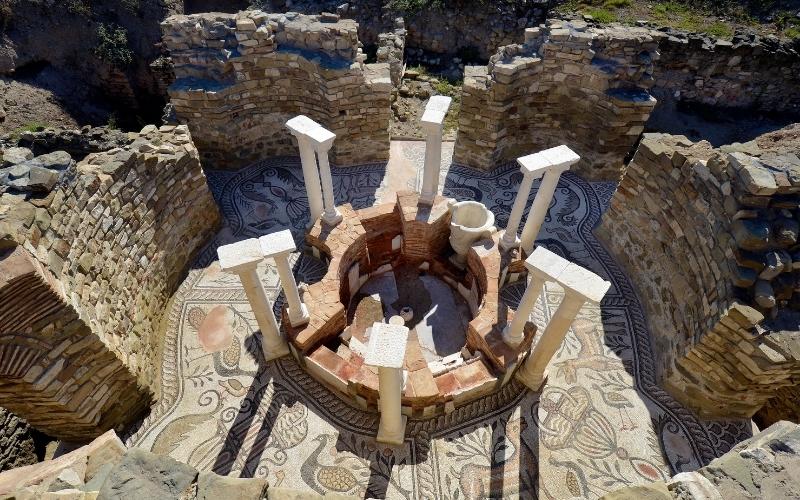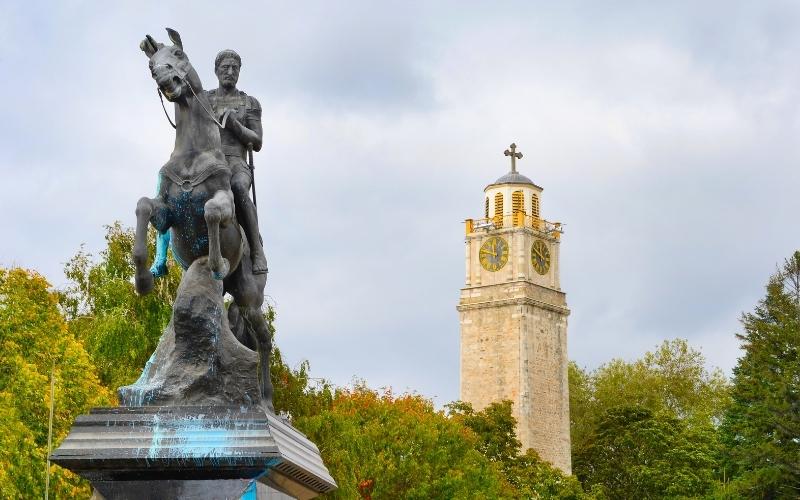We will take a closer look at Macedonian history, but first, why not learn about this European country a bit more?
The Republic of Macedonia is a small, landlocked country on the Balkan Peninsula in Southeast Europe. The country’s culture, architecture, and language were shaped by the empires that ruled this region throughout history.
Due to its geographical position, this area never saw peace for longer than a few decades in the past, attracting the kings and rulers from its very beginning.
The landmarks that testify of the Roman, Greek, Byzantine, and Ottoman influences are still easy to spot all over the country, including the country’s capital Skopje.
However, the most noticeable influence is left by the Ottomans. They ruled Macedonia for more than 500 years, from the mid-14th until the early 20th century.

Macedonian History: A Glance at the Turbulent Past
Although modern Macedonia was formed in 1991 after declaring independence from Yugoslavia, the history of this region is millennia-long.
It was that very history that caused a dispute between Macedonians and Greeks in modern times. North Macedonia constitutes approximately the third of the larger geographical region of Macedonia, the rest of it belonging to Greece and a small part to Bulgaria.
North Macedonia and Greece sparred for almost two decades over who is entitled to the history of ancient Macedonia as its own.
As a result of this dispute, the country acknowledged the former Yugoslav Republic of Macedonia.
Finally, in 2019, the country changed its name to the Republic of North Macedonia.
So, let’s take a closer look at Macedonian history, both rich and turbulent, and learn a bit about this beautiful European country’s times gone by.
The Ancient World
If we want to investigate Macedonian history, we need to go way back in the past. The human population has inhabited this region for millennia – the archeological evidence shows that the Neolithic civilization occupied this region between 7000 and 3500 BCE.
During the first millennium BCE, this region was populated by various tribes – Dacians, Thracians, Illyrians, Celts, and Greeks.
However, the history of Macedonia begins with the Kingdom of Paeonia in the late fifth – early sixth century BCE. Paeonia’s boundaries occupied most of present-day North Macedonia, a small part of south-western Bulgaria, and the north-central part of Greek Macedonia.
The Kingdom of Macedonia: King Philip II and Alexander the Great
Significant roles in Macedonian history play king Philip II and his son Alexander III (the Great).
During the fourth century BCE, Philip II of Macedon incorporated the area into the kingdom of Macedonia. From 359 to 336 BCE, He ruled Macedonia, using military and diplomatic means to unite the southern Greek city-states with the north and establish a federation of Greek states known as the League of Corinth.
He laid the foundations for the kingdom’s expansion under his son, Alexander III the Great.
King Phillip II of Macedon improved his army and developed plans to conquer other lands in the Mediterranean and Asia.
However, he was assassinated by a royal bodyguard before he was able to realize his plans.
King Phillip II was succeeded by his son Alexander. The latter conquered the Persian Empire and expanded his empire to Asia and India, laying the foundations for the Hellenistic age in this region.
The Romans
The Romans began to expand into the Balkan Peninsula at the end of the third century BCE. They conquered the kingdom of Macedonia in the second century BCE. They incorporated it into the province of Moesia, a part of the larger province of Macedonia.
Moesia was the Roman province in the southeastern Balkans on today’s Serbia, part of Macedonia, and Bulgaria.
Because Moesia was a border region, the Roman troops built legionary camps along the Danube River. Those camps grew into the principal cities of Moesia, such as Singidunum (today Belgrade, Serbia).
A large number of sites across North Macedonia still witness the influence of Rome in this region. Some of the best-preserved historical monuments include Stobi on the Vardar River and Heraclea Lyncestis (modern Bitola).
In the third century, the Roman Empire was under constant attacks by Goths, Huns, Bulgars, Avars, and other seminomadic tribes.
The Medieval Times
Between the sixth and the eighth century, Slavic tribes settled in Macedonia. Then, during the ninth century, the Slavic missioners Cyril and Methodius began consolidating the Eastern tradition of Christianity in the region.
Until the expansion of the Ottoman empire in the 14th century, Macedonia was under the rule of three European empires: Byzantine (the most powerful economic, military, and cultural empire in Europe at the time), Bulgarian, and Serbian.
The Ottoman Empire
Macedonia was incorporated into the Ottoman Empire at the end of the 14th century. The Ottomans ruled this region for half a millennium until 1913.
Their presence left a significant imprint in Macedonian history, language, tradition, culture, architecture, and food, to be seen everywhere you go in Macedonia.
Following the Balkan Wars in 1912 and 1913, Macedonia came under Serbian rule, which lasted until 1991, when the country declared its independence.

The Most Popular Historic Sites: The Witnesses of Macedonian History
Macedonian past is still well-preserved in the country’s numerous monuments, palaces, temples, baths, and other historic sites.
Here are some of the most famous witnesses of Macedonian history.
- Stobi
Stobi is one of Macedonia’s best-preserved and most famous archeological sites. The capital of ancient Paeonia, this renowned site treasures numerous ancient ruins, such as streets, mosaics, palaces, baths, temples, and a theatre dating back to the second century AD.
- Heraklea Lycenstis
Heraklea Lycenstis was an ancient Greek city in Macedon, founded by King Philip around the fourth century BCE. The city’s ruins are located about 2 kilometres from the present-day town of Bitola.
- The Skopje Aqueduct
The well-preserved stone aqueduct north of the capital of Skopje is believed to have been built by the ancient Romans. It features fifty-five archways used until the 18th century to supply public Turkish hammams with water.
Each of the empires that occupied this region has left its cultural and architectural imprint upon cities across Macedonia. These places give a closer look at Macedonian history and, as such, are well worth a visit.
